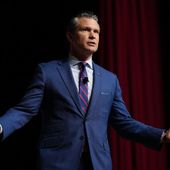Several states are looking to hire independent panels to oversee the implementation of police reforms and lawmakers are also considering legislation that would force police to don body cameras in the wake of another instance where a white officer killed an unarmed black man.
Emotions continue to run high in the aftermath of the videotaped shooting of Walter Lamar Scott, an unarmed black man who was trying to flee arrest, by North Charleston, South Carolina Police Officer Michael Slager, who has been charged with murder in the case. Mr. Slager fired eight shots at the 50-year-old man as he ran away, but claimed to officials later he fired the shots in self-defense.
On Thursday, a video shot from the dashboard camera in the police officer’s squad car showed the initial interactions of the fatal encounter, with Mr. Scott bolting from his stopped Mercedes when the officer returns to his car to check information he has been given. The later clash and shooting, filmed by bystander Feidin Santana, a barber from the Dominican Republic, was not captured in the police video.
The case has reignited calls by civil rights groups who say reforms are needed within the nation’s police departments to overcome the mentality to protect their own.
The South Carolina police department said Thursday it has decided to take another look at a previous use-of-force case against Mr. Slager that was closed two years ago, even though witnesses said investigators never contacted them.
In that case Mr. Slager was exonerated of any wrongdoing in a 2013 case involving his use of a Taser against another unarmed black man.
City officials and police departments across the nation are calling for more body cameras to be worn on officers and outsourcing cases where cops are accused of excessive force to independent panels.
North Charleston’s Mayor Keith Summey said his department had ordered 100 body cameras, and on Wednesday, made another order of 150 so that every officer will have one.
President Obama asked Congress for $263 million for body cameras after a white police officer shot and killed a black, unarmed teenager in Ferguson, Missouri, in August 2014. If Congress approves, the money would go toward matching state funding for cameras, which could help shine a light on ethics and civil rights violations among officers.
Officials in the city of Cleveland, Ohio — the target of a scathing Department of Justice report last year — are working to find an independent monitor who will investigate cases of excessive force.
“People who came and testified were frustrated that the current makeup of the way we investigate allegations of review by police are biased,” Matt Zone, a member of the Cleveland City Councilman who oversees the council’s public safety committee, told The Washington Times. Critics are calling for a stronger Civilian Police Review Board and public disclosure of how that board operates.
Federal investigations have led to two indictments in recent weeks involving suspected excessive use of force and violation of civil rights.
On March 31, a former Mississippi deputy was indicted on federal charges of using a stun gun to assault a detainee at a local jail in 2012 — an act that resulted in bodily injury.
Meanwhile, in Missouri, a state at the epicenter of the police reform movement, former police officer Timothy Runnels pled guilty in late March to using his stun gun to apply excessive force to 17-year-old Bryce Masters during a traffic stop. The electric jolt form the gun caused the teen to go into cardiac arrest. Doctors had to place him in a medically-induced coma and treat him for lack of oxygen to the brain.
• Maggie Ybarra can be reached at mybarra@washingtontimes.com.




Please read our comment policy before commenting.